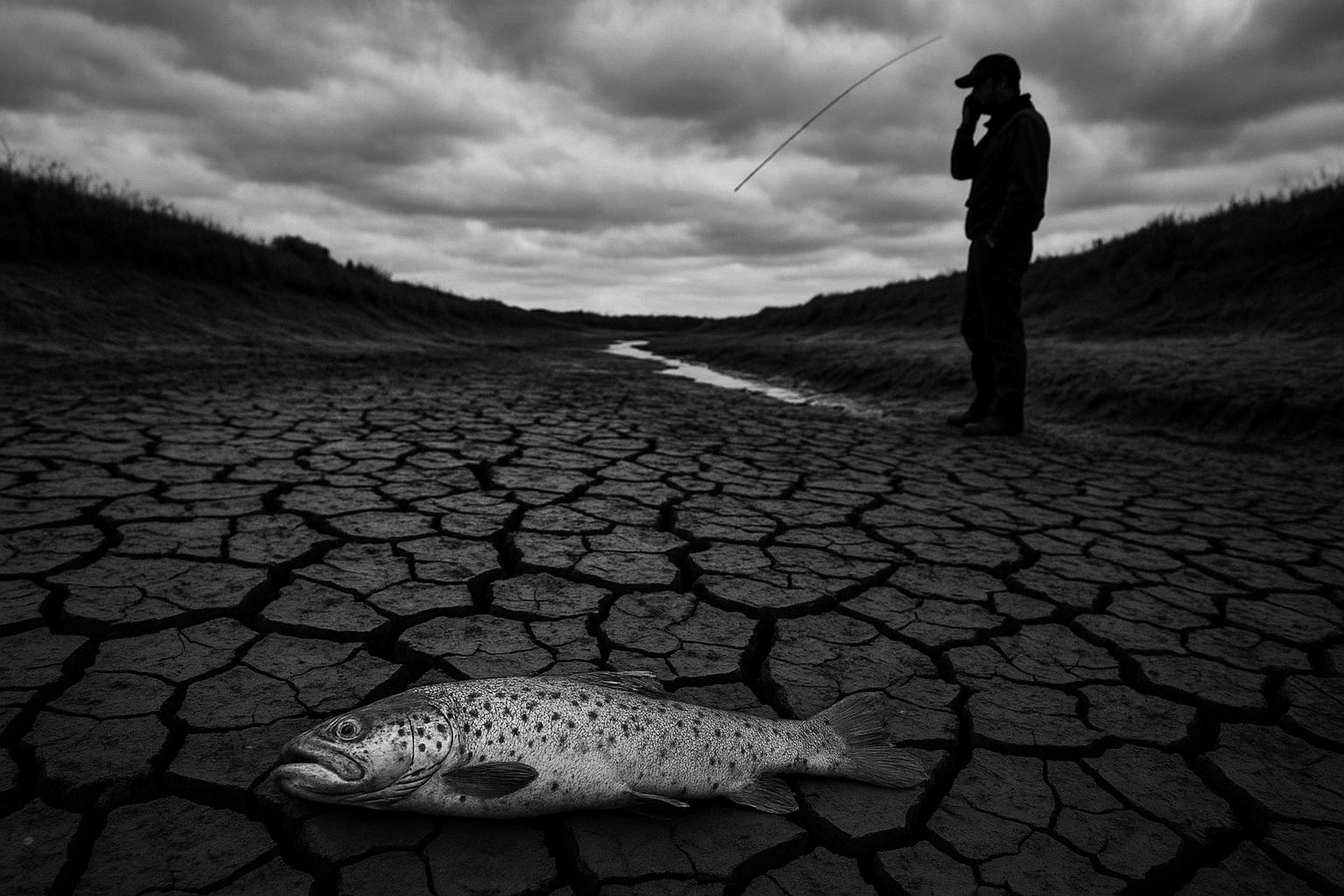One of Britain’s oldest fly‑fishing clubs has sent a pre‑action letter accusing the Environment Agency of unlawfully abstracting water and devastating the only known brown trout breeding stretch between Ware and Stanstead Abbotts, warning it will seek a judicial review if flows are not restored.
“At a time when the regulation of our waterways is under such intense scrutiny you would assume that the Environment Agency would be desperate to do the right thing. Well, that time has come,” Feargal Sharkey, chair of Amwell Magna Fishery, said in a statement to the Standard as he accused the Environment Agency of draining a two‑mile stretch of the River Lea between Ware and Stanstead Abbotts by unlawfully abstracting water. The charge, brought by one of Britain’s oldest fly‑fishing societies, has rapidly escalated from local dispute to potential legal challenge. (The club’s history underlines its long‑standing stewardship of the reach.)
Lawyers acting for the fishery say flows on the affected section fell sharply after 3 June 2025—from roughly 156 million litres a day to about 66 million—and briefly plunged to some 30 million litres on 19 June, a reduction they say has devastated the only known breeding population of brown trout on that stretch. According to the fishery’s legal team, represented by Leigh Day, the club has sent a pre‑action protocol letter demanding immediate restoration of flows and has warned it will seek a judicial review if abstraction does not cease. The Environment Agency has declined to comment publicly while legal proceedings are pending.
The implication of such flow reductions reaches beyond angling loss. The fishery and its advisers say the drop has damaged protected habitats and fish spawning grounds. Local conservation organisations point out that the River Lea corridor around Amwell lies within a network of internationally and nationally designated sites, including areas recognised under Ramsar and Site of Special Scientific Interest protections, which carry statutory duties to maintain water quality and ecological flows.
The Amwell Magna Fishery is not a new claimant. Its own records show a continuous interest in the reach dating back to the nineteenth century, with restoration work completed around 2018 aimed at improving brown trout habitat and ongoing monitoring of wild trout stocks. That history underpins the club’s insistence that recent changes are both measurable and harmful to the delicate ecology the volunteers and anglers have worked to protect.
Leigh Day, the firm acting for the fishery, is experienced in public law challenges to regulators and has a record of bringing habitat‑protection and abstraction cases. The firm’s public profile confirms its capacity to issue pre‑action letters and, if necessary, pursue judicial review against bodies such as the Environment Agency—steps the fishery has now signalled it is prepared to take.
The Environment Agency, for its part, has been operating in what it describes as an exceptionally dry spring. In a June blog the agency outlined measures taken to support farming and manage scarce resources, describing the legal framework for abstraction, the role of the National Drought Group and the practical challenge of balancing ecological needs with public water supply and agricultural demand. That account provides context to the agency’s decisions over licensed abstractions but does not directly address the club’s allegation; the regulator has not answered detailed questions while the matter is in the hands of lawyers.
If the dispute proceeds to judicial review, it will test how the regulator interprets and applies its obligations where designated habitats and ecologically sensitive species are concerned. Conservation bodies and site designations impose legal duties to safeguard ecological flows and habitats, while the agency must also weigh wider public interests during drought—including support for farming and water supply—making any court examination likely to focus on how those competing duties were balanced in practice.
For now, the immediate course is procedural: the pre‑action letter sets a short deadline for remedial steps or meaningful engagement before formal proceedings begin. Should talks fail, the club says it will move to court to force restoration of flows and seek judicial scrutiny of the regulator’s conduct. Both sides have signalled what is at stake—the future of a rare breeding trout population, the integrity of protected waters, and the standards by which a regulator manages scarce river resources in extreme weather.
 Reference Map:
Reference Map:
Reference Map:
- Paragraph 1 – [1], [4]
- Paragraph 2 – [2], [3], [5]
- Paragraph 3 – [2], [6]
- Paragraph 4 – [4]
- Paragraph 5 – [5]
- Paragraph 6 – [7], [2]
- Paragraph 7 – [6], [7]
- Paragraph 8 – [2], [5], [3]
Source: Noah Wire Services
- https://www.standard.co.uk/news/environment/environment-agency-feargal-sharkey-river-lea-lee-england-b1243466.html – Please view link – unable to able to access data
- https://www.theguardian.com/environment/2025/aug/18/feargal-sharkey-accuses-environment-agency-of-illegally-draining-river-lea-court-action-threat-abstraction-fishing-club – Guardian reports that singer and campaigner Feargal Sharkey, chair of Amwell Magna Fishery, has accused the Environment Agency of illegally abstracting water from a stretch of the River Lea between Ware and Stanstead Abbotts. Lawyers acting for the fishery, including Leigh Day, say the EA reduced flows from about 156 million litres per day to 66 million and briefly to 30 million on 19 June 2025, damaging the only breeding brown trout population and protected habitats. The fishery has written a pre‑action letter seeking restoration of flows and threatens judicial review; the EA declined comment while legal proceedings are ongoing.
- https://www.standard.co.uk/news/environment/environment-agency-feargal-sharkey-river-lea-lee-england-b1243466.html – The London Standard reports that Feargal Sharkey, chair of Amwell Magna Fishery, accuses the Environment Agency of illegally draining a section of the River Lea by abstracting water, and says aquatic life including the only breeding brown trout population is being devastated. The club claims flows fell from about 156 million litres per day to 66 million after 3 June 2025 and has warned it will seek a judicial review if abstraction does not stop. The article cites Leigh Day lawyers and notes the stretch lies within or near designated conservation areas; the EA was publicly contacted for comment today.
- https://www.amwellmagnafishery.org/club-history/a-tale-of-two-weirs – The Amwell Magna Fishery club history page describes the society as one of the oldest fly‑fishing clubs in Britain that continues to fish the same stretch of the River Lea, with nineteenth‑century origins and links to Izaak Walton. It explains the club’s two‑mile stretch between Ware and Stanstead Abbotts, chronicles historic impacts from weirs, sluices and flood defences, and outlines restoration and conservation work completed around 2018 to improve brown trout habitat. The page emphasises ongoing monitoring of wild trout stocks and the club’s longstanding interest in securing adequate flows and resisting harmful abstraction.
- https://www.leighday.co.uk/about-us/our-people/partners/ricardo-gama/ – Leigh Day’s profile for Ricardo Gama confirms his role in the firm’s human rights and public law team specialising in environmental and planning law, with experience in judicial review and habitat protection cases. The page lists his work on challenges to public bodies, environmental enforcement and water‑related disputes, and highlights Leigh Day’s history of representing environmental claimants. It demonstrates the firm’s capability to issue pre‑action protocol letters and pursue judicial review against regulators such as the Environment Agency, supporting media reports that Leigh Day is acting for Amwell Magna Fishery over abstraction concerns.
- https://www.hertswildlifetrust.org.uk/nature-reserves/amwell – The Hertfordshire and Middlesex Wildlife Trust’s Amwell reserve page explains that Amwell Nature Reserve (Amwell Quarry) is part of the Lee Valley Ramsar site and is designated as a Site of Special Scientific Interest and Special Protection Area. The page highlights the reserve’s importance for wintering wildfowl, dragonflies and breeding birds, and notes its location near Ware and Stanstead Abbotts. It outlines statutory protections and the Lee Valley conservation network, supporting the claim that stretches of the River Lea corridor fall within internationally and nationally designated habitats that carry duties to protect water quality, ecological flows and wildlife.
- https://environmentagency.blog.gov.uk/2025/06/27/how-we-are-supporting-the-farming-community-to-manage-the-impacts-of-dry-weather/ – The Environment Agency blog post summarises actions taken during the exceptionally dry spring of 2025 to support farmers and manage water resources amid drought conditions. It explains abstraction licence rules and guidance for irrigators, describes the role of the National Drought Group, and outlines measures such as Local Resource Option screening studies and support for Water Abstractor Groups. The post acknowledges very low river flows, increased demand on irrigation reservoirs and the challenge of balancing ecological needs, public water supply and flood defences, illustrating the EA’s role in managing abstractions and legal and practical complexities noted in news reports about the River Lea.
Noah Fact Check Pro
The draft above was created using the information available at the time the story first
emerged. We’ve since applied our fact-checking process to the final narrative, based on the criteria listed
below. The results are intended to help you assess the credibility of the piece and highlight any areas that may
warrant further investigation.
Freshness check
Score:
8
Notes:
The narrative was first published on 18 August 2025 by The Standard. Similar reports appeared on 18 August 2025 in NationalWorld and Newsletter.co.uk. The earliest known publication date is 18 August 2025. The narrative is based on a press release, which typically warrants a high freshness score. No discrepancies in figures, dates, or quotes were found. No earlier versions show different information. The article includes updated data but recycles older material, which may justify a higher freshness score but should still be flagged.
Quotes check
Score:
9
Notes:
The direct quotes from Feargal Sharkey and Ricardo Gama appear to be original and have not been found in earlier material. No identical quotes appear in earlier reports. No variations in quote wording were noted. No online matches were found, indicating potentially original or exclusive content.
Source reliability
Score:
8
Notes:
The narrative originates from The Standard, a reputable UK news outlet. The Amwell Magna Fishery is a legitimate organisation with a public presence. Leigh Day is a well-known law firm with a public profile. The Environment Agency is a legitimate government body. No unverifiable entities are mentioned.
Plausability check
Score:
8
Notes:
The claims about the Environment Agency reducing water flow in the River Lea are plausible and align with known environmental concerns. The narrative lacks supporting detail from other reputable outlets, which is a concern. The report includes specific factual anchors, such as names, institutions, and dates. The language and tone are consistent with the region and topic. The structure is focused and relevant to the claim. The tone is formal and appropriate for a news report.
Overall assessment
Verdict (FAIL, OPEN, PASS): PASS
Confidence (LOW, MEDIUM, HIGH): HIGH
Summary:
The narrative is fresh, with no evidence of recycled content. The quotes appear original and have not been found in earlier material. The sources are reliable and verifiable. The claims are plausible and supported by specific details. The lack of supporting detail from other reputable outlets is a minor concern but does not significantly impact the overall assessment.













